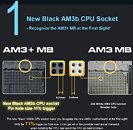Tuesday, April 26th 2011

ASRock Uses ''Real'' AM3+ Sockets, Lists Out Advantages Over AM3
ASRock launched a new marketing campaign for its AMD platform motherboards, claiming to be the first manufacturer to be out with motherboards that use real AM3+ sockets. AM3+ is the FCPGA socket that has been designed for upcoming AMD FX series "Zambezi" processors based on the "Bulldozer" architecture. As a part of its campaign, ASRock highlighted the benefits of opting for its AM3+ motherboards. In the process, it ended up disclosing quite some technical information about AM3+, and why AMD designed it in the first place, when apparently AM3 can run Zambezi with a BIOS update.
To begin with, ASRock started with the socket itself, showing that AM3+ sockets can be identified by "AM3b" written on the socket, and have wider pin-holes (0.51 mm vs. 0.45 mm of AM3). It is possible that future (retail?) versions of the CPU, if not the engineering samples doing rounds, could use packages with thicker pins that are incompatible with AM3. The thicker pins add durability, and are designed for a different set of electrical specifications.As part of those different set of electrical specifications, AM3+ processors are designed to talk to voltage controllers over a different VID, that's 3.4 MHz VID, while AM3 socket can only handle 400 KHz VID. Even if AM3+ chips run on AM3, they might probably lack some power management features, because AM3 boards' controllers might not support them. AM3+ will also feature a more advanced load-line design that lets controllers monitor electrical loads of the CPU and keep voltages within a stable range, minimizing vDroop (lowering of vCore with higher than normal load (when overclocked, loaded), messes up OC stability). AMD's new load-line design increases efficiency by up to 11.8%.AMD's new electrical specification, coupled with ASRock's implementation are claimed to reduce CPU power electrical noise by up to 22%. This has a direct impact on energy efficiency. Also, there's a reason those pins are thicker: the package is designed to handle 32% higher current than AM3, the AM3+ is designed to handle 145A, while AM3 was designed for 110A.Lastly, with AM3+, AMD changed the CCR (Combo Cooler Retention Module), that plastic frame around the socket to hold the cooler, to be a two part kit, instead of the single-piece frame since s754. The two-piece CCR design first came to be with s1207, then on to other server sockets, and now makes its entry to the client platform with AM3+. The two-piece design ensures that air blown downwards by top-flow coolers make it to the VRM circuitry, with no plastic bars obstructing it. ASRock listed out specifications of all its AM3+ motherboards. They're based on AMD 8-series chipsets.
To begin with, ASRock started with the socket itself, showing that AM3+ sockets can be identified by "AM3b" written on the socket, and have wider pin-holes (0.51 mm vs. 0.45 mm of AM3). It is possible that future (retail?) versions of the CPU, if not the engineering samples doing rounds, could use packages with thicker pins that are incompatible with AM3. The thicker pins add durability, and are designed for a different set of electrical specifications.As part of those different set of electrical specifications, AM3+ processors are designed to talk to voltage controllers over a different VID, that's 3.4 MHz VID, while AM3 socket can only handle 400 KHz VID. Even if AM3+ chips run on AM3, they might probably lack some power management features, because AM3 boards' controllers might not support them. AM3+ will also feature a more advanced load-line design that lets controllers monitor electrical loads of the CPU and keep voltages within a stable range, minimizing vDroop (lowering of vCore with higher than normal load (when overclocked, loaded), messes up OC stability). AMD's new load-line design increases efficiency by up to 11.8%.AMD's new electrical specification, coupled with ASRock's implementation are claimed to reduce CPU power electrical noise by up to 22%. This has a direct impact on energy efficiency. Also, there's a reason those pins are thicker: the package is designed to handle 32% higher current than AM3, the AM3+ is designed to handle 145A, while AM3 was designed for 110A.Lastly, with AM3+, AMD changed the CCR (Combo Cooler Retention Module), that plastic frame around the socket to hold the cooler, to be a two part kit, instead of the single-piece frame since s754. The two-piece CCR design first came to be with s1207, then on to other server sockets, and now makes its entry to the client platform with AM3+. The two-piece design ensures that air blown downwards by top-flow coolers make it to the VRM circuitry, with no plastic bars obstructing it. ASRock listed out specifications of all its AM3+ motherboards. They're based on AMD 8-series chipsets.







55 Comments on ASRock Uses ''Real'' AM3+ Sockets, Lists Out Advantages Over AM3
If the pins on an AM3+ CPU are a heavier gauge than AM3 CPUs then how is an AM3 CPU supposed to fit in a AM3+ socket? The only way is for the contacts in the socket to be highly compressed making them extra tight on an AM3+. Also if the PINs are a heavier gauge on AM3+ cpu then people buying the ASUS bios claim will be getting screwed as there will be no way to fit the AM3+ in an AM3 socket (never mind the extra pin even). Also an increase in gauge signifies higher current draw, which means a lot of AM3 boards would not be able to handle the load.
In so far as the new retention scheme, airflow my buttocks, it's cheaper, that's why. The air coming from a CPU fan is hot, so you're blowing hot air on the VRM's. Sounds like they don't want to spend the money on heat sinks for the VRMs :p
I think one's best bet is to wait for the 9x chip sets and buy a AM3+ board with those. It's the only way to be sure you are at spec with the platform.
I planned on taking an AM3 quad to the new socket but now I don't know with this pin issue. Maybe Intel get's me back as a customer (last Intel chip was a PII 400).
OMG, DO WANT! :rolleyes:
Plus, as already written, if you are sufficiently careful and gentle it shouldn't go wrong.
I was thinking one similar to the 479 adapter, though this is clearly for Intel processors, I am sure AMD is intelligent enough to market a similar adapter for already existing AM3 boards. (I would hope)
The fact of the matter is that pins on the motherboard are far less likely to be damanged than pins on a processor. To damage pins on a motherboard you have to be an idiot and drop something directly on that spot of the board, or try to touch the pins, or put the processor in wrong. With pins on the processor, you just have to drop the processor, which is a lot more likely than damaging a pin on a motherboard.AMD has already moved to LGA on the server side, because it is just a better design. The only reason AMD has stuck with ZIF sockets on the desktop side is to maintain backwards compatibility.
And when your tearing a machine down to say replace a bad motherboard, you don't always have a nice protective case to put it in, so its on the desk while you swap out the motherboard, easily knocked off.
And even if you are just installing it new, it is possible to drop the processor on the way from the package to the motherboard, and have it bounce off of the desk and hit the floor. I've seen it happen, never done it personally, but seen it happen.
There are so many more scenarios, and more likely scenarios as well, that lead to bent pins on a processor than there are that lead to bent pins on a motherboard.
Can you see it now?
:roll:
personaly. i´ve had enough ram issues with AMD. im going to keep my 790FX board and DDR2 untill 990FX boards come out. i see no point in using a board with a AM3 chipset "updated" to run at DDR3 1600.
I assume with 32nm the voltage will drop but the transistor count will make a big jump, would the extra current just be something that's needed to power a butt load more transistors at a lower voltage?
Could the max current effect the max TDP CPU that could be put out for AM3+?
I really have no clue how the CPU voltage, CPU TDP wattage and socket current relate, as in what current would a 140w 965be pull but at what voltage and how much would upping the voltage up the current?
It makes me wonder how much current i have been sucking on when at something like 4ghz @ 1.5v.